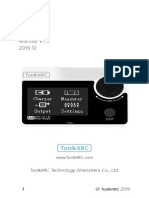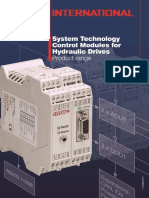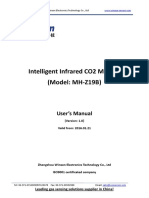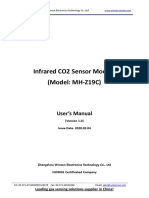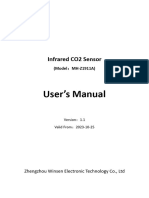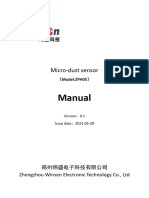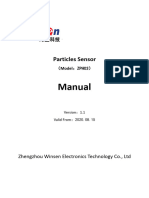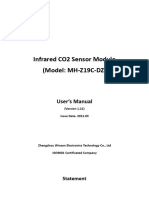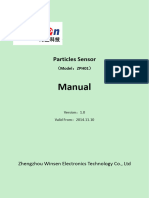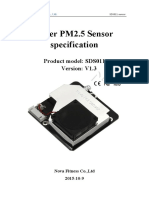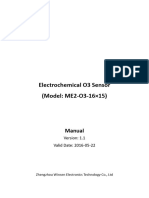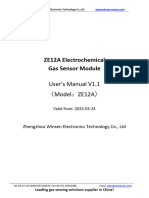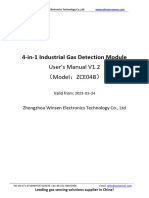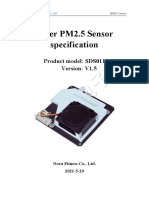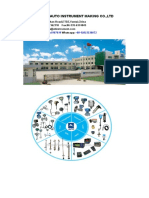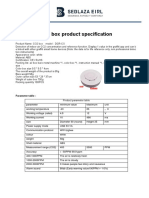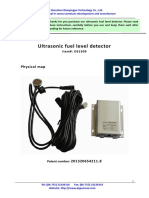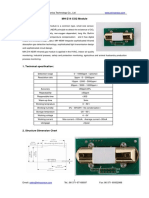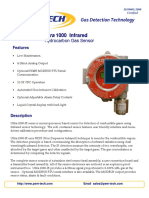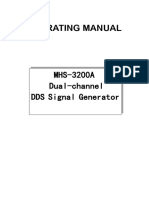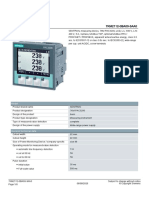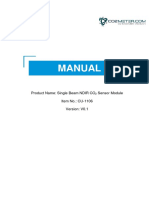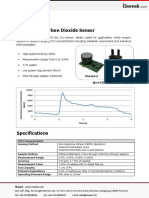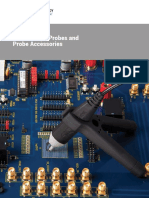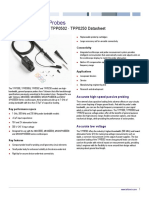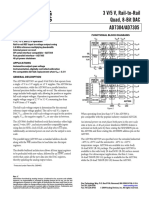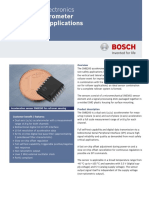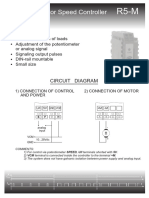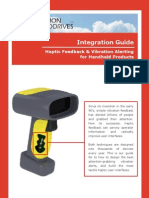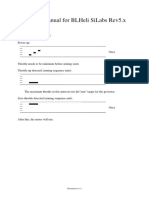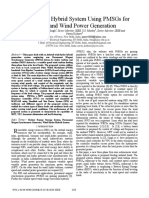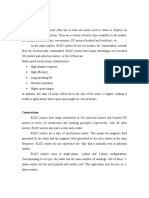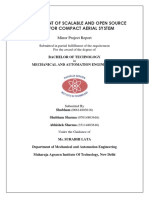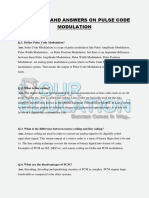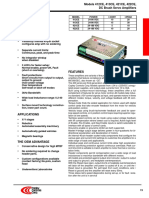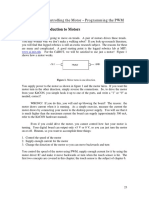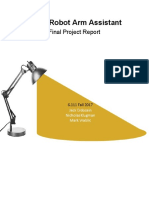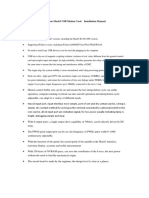Infrared CO2 Sensor Module (Model: MH-Z19B) : User's Manual
Infrared CO2 Sensor Module (Model: MH-Z19B) : User's Manual
Uploaded by
Avs ElectronCopyright:
Available Formats
Infrared CO2 Sensor Module (Model: MH-Z19B) : User's Manual
Infrared CO2 Sensor Module (Model: MH-Z19B) : User's Manual
Uploaded by
Avs ElectronOriginal Description:
Original Title
Copyright
Available Formats
Share this document
Did you find this document useful?
Is this content inappropriate?
Copyright:
Available Formats
Infrared CO2 Sensor Module (Model: MH-Z19B) : User's Manual
Infrared CO2 Sensor Module (Model: MH-Z19B) : User's Manual
Uploaded by
Avs ElectronCopyright:
Available Formats
Zhengzhou Winsen Electronics Technology Co., Ltd www.winsen-sensor.
com
Infrared CO2 Sensor Module
(Model: MH-Z19B)
User’s Manual
(Version: 1.6)
Issue Date. 2020.04.23
Zhengzhou Winsen Electronics Technology Co., Ltd
ISO9001 certificated company
Tel: 86-371-67169097/67169670 Fax: 86-371-60932988 Email: sales@winsensor.com
Leading gas sensing solutions supplier in China!
Zhengzhou Winsen Electronics Technology Co., Ltd www.winsen-sensor.com
Statement
This manual’s copyright belongs to Zhengzhou Winsen Electronics Technology Co., LTD. Without
the written permission, any part of this manual shall not be copied, translated, stored in database
or retrieval system, also can’t spread through electronic, copying, record ways.
Thanks for purchasing our product. In order to let customers use it better and reduce the faults
caused by misuse, please read the manual carefully and operate it correctly in accordance with the
instructions. If users disobey the terms or remove, disassemble, change the components inside of
the sensor, we shall not be responsible for the loss.
The specific such as color, appearance, sizes &etc., please in kind prevail.
We are devoting ourselves to products development and technical innovation, so we reserve the
right to improve the products without notice. Please confirm it is the valid version before using this
manual. At the same time, users’ comments on optimized using way are welcome.
Please keep the manual properly, in order to get help if you have questions during the usage in the
future.
Zhengzhou Winsen Electronics Technology CO., LTD.
Tel: 86-371-67169097/67169670 Fax: 86-371-60932988 Email: sales@winsensor.com
Leading gas sensing solutions supplier in China!
Zhengzhou Winsen Electronics Technology Co., Ltd www.winsen-sensor.com
MH-Z19B NDIR CO2 Module
1. Profile
MH-Z19B NDIR infrared gas module is a common type, small size sensor, using non-dispersive infrared (NDIR)
principle to detect the existence of CO2 in the air, with good selectivity, non-oxygen dependent and long life.
Built-in temperature compensation; and it has UART output and PWM output. It is developed by the tight
integration of mature infrared absorbing gas detection technology, precision optical circuit design and
superior circuit design.
2. Applications
*HVAC refrigeration *Air cleaner device *Indoor air quality monitoring
*Smart home *Ventilation system *School
3. Main Features
Chamber is gold plated, water-proof and anti-corrosion
High sensitivity, low power consumption
Good stability
Temperature compensation, excellent linear output
Multiple output modes: UART, PWM
Long lifespan
Anti-water vapor interference, anti-poisoning
4. Structure
Tel: 86-371-67169097/67169670 Fax: 86-371-60932988 Email: sales@winsensor.com
Leading gas sensing solutions supplier in China!
Zhengzhou Winsen Electronics Technology Co., Ltd www.winsen-sensor.com
Terminal connection type:
Pins connection type: Unit: mm
Pin is the common standard type with square cross section.
Pins connection type:
Pin Pin Definition
Vin Positive pole of power (Vin)
GND Negative pole of power (GND)
PWM PWM
HD(zero point calibration, low level
Hd
lasting for over 7s is effective)
Rx UART(RXD)TTL Level data input
Tx UART(TXD)TTL Level data output
Vo reserved
SR reserved
AOT reserved
Tel: 86-371-67169097/67169670 Fax: 86-371-60932988 Email: sales@winsensor.com
Leading gas sensing solutions supplier in China!
Zhengzhou Winsen Electronics Technology Co., Ltd www.winsen-sensor.com
Terminal connection type:
Pin Terminal pin Definition
Pin 1 reserved
Pin 2 reserved
Pin 3 Negative Pole of power (GND)
Pin 4 Positive Pole of power(Vin)
Pin 5 UART(RXD)TTL Level data input
Pin 6 UART(TXD)TTL Level data output
Pin 7 reserved
Note: All the pins for reserved must be vacant while the sensor is working.
5. Detection range and accuracy
Detection Gas Formula Detection Range Accuracy
0~2000ppm
Carbon Dioxide CO2 0~5000ppm ± (50ppm+5% reading value)
0~10000ppm
6. Main parameters
Model No. MH-Z19B
Detection Gas CO2
Working voltage 4.5 ~ 5.5 V DC
Average current < 20mA (@5V power supply)
Peak current 150mA (@5V power supply)
Interface level 3.3 V (Compatible with 5V)
Detection Range 0~2000/5000/10000ppm(optional)
Serial Port (UART) (TTL level 3.3V)
Output signal
PWM
Preheat time 3 min
Response Time T90 < 120 s
Working temperature -10 ~ 50 ℃
Working humidity 0 ~ 95% RH (No condensation)
Weight 5g
Lifespan > 5 years
Tel: 86-371-67169097/67169670 Fax: 86-371-60932988 Email: sales@winsensor.com
Leading gas sensing solutions supplier in China!
Zhengzhou Winsen Electronics Technology Co., Ltd www.winsen-sensor.com
7. Output
PWM output
Take 0~2000ppm for example
CO2 output range 0~2000ppm
Cycle 1004ms±5%
Cycle start high level output 2ms(theoretical value)
The middle cycle 1000ms±5%
cycle end low level output 2ms(theoretical value)
CO2 concentration: Cppm=2000×(TH-2ms)/(TH+TL-4ms)
Cppm: CO2 concentration could be calculated by PWM output
TH high level output time during cycle
TL low level output time during cycle
Serial port output (UART)
Hardware connection
Connect module’s Vin-GND-RXD-TXD to users’ 5V-GND-TXD-RXD.
(Users must use TTL level. If RS232 level, it must be converted.)
Software setting
Set serial port baud rate be 9600, data bytes have 8 bytes, stop byte has 1 byte, parity byte is null.
Commands
0x86 Read CO2 concentration
0x87 Calibrate Zero Point (ZERO)
0x88 Calibrate Span Point (SPAN)
Tel: 86-371-67169097/67169670 Fax: 86-371-60932988 Email: sales@winsensor.com
Leading gas sensing solutions supplier in China!
Zhengzhou Winsen Electronics Technology Co., Ltd www.winsen-sensor.com
0x86- Read CO2 concentration
Sending command
Byte0 Byte1 Byte2 Byte3 Byte4 Byte5 Byte6 Byte7 Byte8
Start Byte Reserved Command - - - - - Checksum
0xFF 0x01 0x86 0x00 0x00 0x00 0x00 0x00 0x79
Return value
Byte0 Byte1 Byte2 Byte3 Byte4 Byte5 Byte6 Byte7 Byte8
Start Byte Command Concentration Concentration - - - - Checksum
(High 8 Byte) (Low 8 Byte)
0xFF 0x86 HIGH LOW - - - - Checksum
CO2 concentration = HIGH * 256 + LOW
For example: Send command FF 01 86 00 00 00 00 00 79, Return value FF 86 01 F4 00 00 00 00 85
How to calculate concentration: convert hexadecimal 01 into decimal 1, hexadecimal F4 into decimal 254, then 1*256+254=500ppm
1. Checksum calculation method
Checksum = (Negative (Byte1+Byte2+Byte3+Byte4+Byte5+Byte6+Byte7))+1
For example:
Byte0 Byte1 Byte2 Byte3 Byte4 Byte5 Byte6 Byte7 Byte8
Start Byte Reserved Command - - - - - Checksum
0xFF 0x01 0x86 0x00 0x00 0x00 0x00 0x00 Checksum
Calculating Checksum:
1、Add Byte 1 to Byte 7: 0x01 + 0x86 + 0x00 + 0x00 + 0x00 + 0x00 + 0x00 = 0x87
2、Negative: 0xFF - 0x87 = 0x78
3、Then+1:0x78 + 0x01 = 0x79
C language
char getCheckSum(char *packet)
{
char i, checksum;
for( i = 1; i < 8; i++)
{
checksum += packet[i];
}
checksum = 0xff – checksum;
checksum += 1;
return checksum;
}
Tel: 86-371-67169097/67169670 Fax: 86-371-60932988 Email: sales@winsensor.com
Leading gas sensing solutions supplier in China!
Zhengzhou Winsen Electronics Technology Co., Ltd www.winsen-sensor.com
8.Zero Point Calibration
About zero point calibration:
This module has three methods for zero point calibration: hand-operated method, sending command method
and self-calibration. All the zero point is at 400ppm CO2 level.
A). Hand-operated method: Connect module’s HD pin to low level(0V), lasting for 7 seconds at least. Before
calibrating the zero point, please ensure that the sensor is stable for more than 20 minutes at 400ppm ambient
environment.
B). To send command method:
Zero and Span point calibration can be achieved by sending a calibration command to the sensor via the serial
port (URAT). Zero and SPAN point calibration commands are as follows:
0x87-To calibrate zero point
Send command
Byte0 Byte1 Byte2 Byte3 Byte4 Byte5 Byte6 Byte7 Byte8
Start Byte reserved Command - - - - - Checksum
0xFF 0x01 0x87 0x00 0x00 0x00 0x00 0x00 Checksum
No returned value
Caution: zero-point means 400ppm, please ensure the module works in 400ppm CO2 gas stably for 20 min at least before send
the command
0x88- To calibrate span point
Send command
Byte0 Byte1 Byte2 Byte3 Byte4 Byte5 Byte6 Byte7 Byte8
Start Byte No. Command Span Span - - - Checksum
(High 8 bits) (low 8 bits)
0xFF 0x01 0x88 HIGH LOW 0x00 0x00 0x00 Checksum
No returned value. If SPAN value is 2000ppm, HIGH=2000/256; LOW=2000%256
Caution:
* Please do Zero calibration before SPAN calibration.
*Before sending the SPAN calibration command, please ensure that the sensor is stable for more than 20 minutes at the
corresponding concentration.
Suggest to take 2000ppm as SPAN calibration point, if need lower concentration, it should be higher than 1000ppm.
C).Self-calibration:
After the module works for some time, it can judge the zero point intelligently and do the zero calibration
automatically. The calibration cycle is every 24 hours since the module is power on. The zero point is 400ppm.
This method is suitable for office and home environment, not suitable for agriculture greenhouse, farm,
refrigerator, etc.. If the module is used in latter environment, please turn off this function.
Tel: 86-371-67169097/67169670 Fax: 86-371-60932988 Email: sales@winsensor.com
Leading gas sensing solutions supplier in China!
Zhengzhou Winsen Electronics Technology Co., Ltd www.winsen-sensor.com
9. Notes
9.1 Please avoid the pressure of its gilded plastic chamber from any direction, during welding, installation, and
use.
9.2 When placed in small space, the space should be well ventilated, especially for diffusion window.
9.3 The module should be away from heat, and avoid direct sunlight or other heat radiation.
9.4 The module should be calibrated termly, the suggested period is not longer than 6 months.
9.5 Do not use the sensor in the high dusty environment for long time.
9.6 To ensure the normal work, the power supply must be among 4.5V~5.5V DC rang, the power current must be
not less than 150mA. Out of this range, it will result in the failure of the sensor. (The concentration output is low,
or the sensor can not work normally.)
9.7 During the zero point calibration procedure by manual, the sensor must work in stable gas environment
(400ppm) for over 20 minutes. Connect the HD pin to low level (0V) for over 7 seconds.
9.8 Forbid using wave soldering for the sensor.
9.9 When soldering with soldering iron, set the temperature to be (350 ± 5) °C, and soldering time must be
within 3 seconds.
9.0 As for pin version sensor, it is recommended to use soldering socket to directly insert or remove sensors for
convenient maintenance.
Zhengzhou Winsen Electronics Technology Co., Ltd
Add: No.299, Jinsuo Road, National Hi-Tech Zone,
Zhengzhou 450001 China
Tel: +86-371-67169097/67169670
Fax: +86-371-60932988
E-mail: sales@winsensor.com
Website: www.winsen-sensor.com
Tel: 86-371-67169097/67169670 Fax: 86-371-60932988 Email: sales@winsensor.com
Leading gas sensing solutions supplier in China!
You might also like
- M8 Manual V1.5Document39 pagesM8 Manual V1.5FmarceloNo ratings yet
- E24000-2!10!14 Control Modules EHCD Product RangeDocument64 pagesE24000-2!10!14 Control Modules EHCD Product RangeSergiy SydorenkoNo ratings yet
- Infrared CO2 Sensor Module (Model: MH-Z19B) : User's ManualDocument10 pagesInfrared CO2 Sensor Module (Model: MH-Z19B) : User's Manualsine summsun PradhanNo ratings yet
- MH z19cDocument8 pagesMH z19cJohan AmbiguNo ratings yet
- MH z19b Co2 Ver1 - 0 PDFDocument9 pagesMH z19b Co2 Ver1 - 0 PDFMacovei Lucian FlorinNo ratings yet
- Winsen MH-Z14A Sensor Manual v1.01Document6 pagesWinsen MH-Z14A Sensor Manual v1.01Gabriel OliveiraNo ratings yet
- Infrared CO2 Sensor Module (Model: MH-Z19C) : User's ManualDocument7 pagesInfrared CO2 Sensor Module (Model: MH-Z19C) : User's ManualrerlgakkbuqysmavtmNo ratings yet
- MH Z19Document9 pagesMH Z19Simone PolinesiNo ratings yet
- MH Z1911aDocument6 pagesMH Z1911aJohan AmbiguNo ratings yet
- MH z14bDocument8 pagesMH z14bJohan AmbiguNo ratings yet
- Manual: NDIR Infrared CO2 Gas SensorDocument6 pagesManual: NDIR Infrared CO2 Gas SensorJohan AmbiguNo ratings yet
- ZH 07Document12 pagesZH 07Johan AmbiguNo ratings yet
- ZE16B-CO Module Manual V1.1Document5 pagesZE16B-CO Module Manual V1.1Mehdi MehdiNo ratings yet
- ZPH 05Document7 pagesZPH 05Johan AmbiguNo ratings yet
- ZPH 01 BDocument10 pagesZPH 01 BJohan AmbiguNo ratings yet
- ZPH 03Document9 pagesZPH 03Johan AmbiguNo ratings yet
- MH-Z19C-DZ-terminal Type CO2 Manual (Ver1.21) - 202103Document9 pagesMH-Z19C-DZ-terminal Type CO2 Manual (Ver1.21) - 202103testNo ratings yet
- ZPH 02Document9 pagesZPH 02Johan AmbiguNo ratings yet
- Ze03 Electrochemical Module Manualv2 - 5Document7 pagesZe03 Electrochemical Module Manualv2 - 5Ильнур ТагировNo ratings yet
- ZPH01 DustDocument8 pagesZPH01 DustGhiban ConstantinNo ratings yet
- SDS011 Laser PM2.5 Sensor Specification-V1.3Document13 pagesSDS011 Laser PM2.5 Sensor Specification-V1.3Divjot SinghNo ratings yet
- SDS011 Laser PM2.5 Sensor Specification-V1.4Document13 pagesSDS011 Laser PM2.5 Sensor Specification-V1.4Jürgen KircherNo ratings yet
- Mainstream ETCO2 Module CM2200 Technical SpecificationDocument13 pagesMainstream ETCO2 Module CM2200 Technical SpecificationEmilio CánepaNo ratings yet
- ZP 14Document8 pagesZP 14Johan AmbiguNo ratings yet
- Laser PM2.5 Sensor Specification: Product Model: SDS011Document13 pagesLaser PM2.5 Sensor Specification: Product Model: SDS011Fredrik LingNo ratings yet
- Zh03b Laser Dust Module v2 1Document11 pagesZh03b Laser Dust Module v2 1Hoan PhamNo ratings yet
- ms1022 gp22 EquivalentDocument60 pagesms1022 gp22 Equivalentdbm100% (1)
- Electrochemical O3 Sensor (Model: ME2-O3-16×15) : ManualDocument6 pagesElectrochemical O3 Sensor (Model: ME2-O3-16×15) : ManualJohan AmbiguNo ratings yet
- ZE12A Electrochemical Gas Sensor ModuleDocument5 pagesZE12A Electrochemical Gas Sensor ModuleJohan AmbiguNo ratings yet
- Zce 04 BDocument6 pagesZce 04 BJohan AmbiguNo ratings yet
- ZP 201Document5 pagesZP 201Johan AmbiguNo ratings yet
- SDS011 Laser PM2.5 Sensor Specification-V1.5Document13 pagesSDS011 Laser PM2.5 Sensor Specification-V1.5SearcherNo ratings yet
- Techincal Specifications With DetailsDocument11 pagesTechincal Specifications With Detailsruturaj v delekarNo ratings yet
- Ultrasonic Fuel Sensor User Manual - 181129Document11 pagesUltrasonic Fuel Sensor User Manual - 181129Carlos MontalvanNo ratings yet
- Selina Product CatalogDocument19 pagesSelina Product Catalogdondon correNo ratings yet
- Carbon Monoxide DM-100-CO PDSDocument2 pagesCarbon Monoxide DM-100-CO PDSroyvindasNo ratings yet
- CO2 Box Product Specification: Parameter TableDocument3 pagesCO2 Box Product Specification: Parameter TableJoséNo ratings yet
- Inclinometer Lca326t PDFDocument10 pagesInclinometer Lca326t PDFManasi NaikNo ratings yet
- Dyp - ds1309Document11 pagesDyp - ds1309alaska112No ratings yet
- Gekko: Portable PAUT For NDTDocument2 pagesGekko: Portable PAUT For NDTManuel AvilaNo ratings yet
- Datasheet Electromagnetic Flow Meter Sup-Ldg: Committed To Process Automation Solutions Tel: 86-15158063876 FDocument16 pagesDatasheet Electromagnetic Flow Meter Sup-Ldg: Committed To Process Automation Solutions Tel: 86-15158063876 FAink Dak bageur theaNo ratings yet
- MH Z14jjjjjknjkDocument3 pagesMH Z14jjjjjknjkBabu DharmarajNo ratings yet
- Ultra1000 IR CombustibleDocument2 pagesUltra1000 IR Combustiblececilia aguilarNo ratings yet
- Open Channel Flow MeterDocument2 pagesOpen Channel Flow MeterNishikant ThakurNo ratings yet
- Sensor CO2 para El 20% KCD - HP - en - 110602 PDFDocument5 pagesSensor CO2 para El 20% KCD - HP - en - 110602 PDFAngelica MarulandaNo ratings yet
- Temp IndicatorDocument1 pageTemp Indicatorpatrik710No ratings yet
- Brochure Dew Point Sensors - ENDocument12 pagesBrochure Dew Point Sensors - ENosmanyildirim85No ratings yet
- v130 33 Ta24 - Dts v130 Ta24 - 10 07Document6 pagesv130 33 Ta24 - Dts v130 Ta24 - 10 07Ecaterina IrimiaNo ratings yet
- KImon Generatore FunzioniDocument19 pagesKImon Generatore FunzionivogiancaNo ratings yet
- Intelligent Infrared Carbon Dioxide Module (Model: MH-Z14A) : Issue Date. May 5, 2019Document10 pagesIntelligent Infrared Carbon Dioxide Module (Model: MH-Z14A) : Issue Date. May 5, 2019udara11No ratings yet
- Dso tc2 Oscilloscope Transistor Tester ManualDocument8 pagesDso tc2 Oscilloscope Transistor Tester ManualLuciano FerreiraNo ratings yet
- A1350 Flyer eDocument2 pagesA1350 Flyer eBojan IlievNo ratings yet
- Specification: Product Name: Laser Particle Sensor Module Item No.: PM2008 Date: February 27, 2019Document24 pagesSpecification: Product Name: Laser Particle Sensor Module Item No.: PM2008 Date: February 27, 2019MIN GU KIMNo ratings yet
- MHS-5200A ManualDocument25 pagesMHS-5200A ManualAndrey VoroninNo ratings yet
- Noncontact Temperature Measurement For Industrial Applications & OemsDocument4 pagesNoncontact Temperature Measurement For Industrial Applications & OemsHpnoteNo ratings yet
- Detector de Gas - TGas-1031Document6 pagesDetector de Gas - TGas-1031Fernando BonillaNo ratings yet
- Data Sheet 7KM2112-0BA00-3AA0: ModelDocument8 pagesData Sheet 7KM2112-0BA00-3AA0: ModelClaudiu VlasceanuNo ratings yet
- Manual CU 1106 Rev1Document17 pagesManual CU 1106 Rev1Jose Maria PerezNo ratings yet
- BS03 Fixed Gas Detector-VOCDocument1 pageBS03 Fixed Gas Detector-VOCtruongNo ratings yet
- DE550016 BA 3 Select 01Document4 pagesDE550016 BA 3 Select 01seve1No ratings yet
- Isweek SprintIR CO2 SensorDocument2 pagesIsweek SprintIR CO2 SensorindustrialNo ratings yet
- Cummins ISX Engine Error Codes. ISM, QSM - Truck PDFDocument35 pagesCummins ISX Engine Error Codes. ISM, QSM - Truck PDFAvs ElectronNo ratings yet
- HSPY ProgrammingDocument7 pagesHSPY ProgrammingAvs ElectronNo ratings yet
- FAULT CODE 4176 - Aftertreatment Selective Catalyst Reduction Air Assist Valve - Voltage Above Normal or Shorted To High SourceDocument7 pagesFAULT CODE 4176 - Aftertreatment Selective Catalyst Reduction Air Assist Valve - Voltage Above Normal or Shorted To High SourceAvs ElectronNo ratings yet
- Qdoc - Tips Cm2220isf 38 Euro 4 Wiringrev20pdfDocument4 pagesQdoc - Tips Cm2220isf 38 Euro 4 Wiringrev20pdfAvs ElectronNo ratings yet
- Passive Probe Accessories For PP007 and PP008 Series: PK007-005 PK007-030 PK007-001Document1 pagePassive Probe Accessories For PP007 and PP008 Series: PK007-005 PK007-030 PK007-001Avs ElectronNo ratings yet
- Oscilloscope Probes and Probe AccessoriesDocument56 pagesOscilloscope Probes and Probe AccessoriesAvs ElectronNo ratings yet
- MMCX Microminiature RF Connectors - Molex - DigiKeyDocument3 pagesMMCX Microminiature RF Connectors - Molex - DigiKeyAvs ElectronNo ratings yet
- Infiniium Oscilloscope Probes and Accessories: Keysight TechnologiesDocument59 pagesInfiniium Oscilloscope Probes and Accessories: Keysight TechnologiesAvs ElectronNo ratings yet
- TEKTRONIX - Test Accessory, BNC To Probe Tip AdapterDocument1 pageTEKTRONIX - Test Accessory, BNC To Probe Tip AdapterAvs ElectronNo ratings yet
- Molex - Connectors, Interconnects - DigiKeyDocument3 pagesMolex - Connectors, Interconnects - DigiKeyAvs ElectronNo ratings yet
- Passive Voltage Probes: TPP1000 TPP0500B TPP0502 TPP0250 DatasheetDocument4 pagesPassive Voltage Probes: TPP1000 TPP0500B TPP0502 TPP0250 DatasheetAvs ElectronNo ratings yet
- PE4576 - Technical Summary For Multilink Universal and Multilink Universal FXDocument5 pagesPE4576 - Technical Summary For Multilink Universal and Multilink Universal FXAvs ElectronNo ratings yet
- Definitions and Properties of Soft FerritesDocument13 pagesDefinitions and Properties of Soft FerritesAvs ElectronNo ratings yet
- Oscilloscope Probe: BNC AdapterDocument1 pageOscilloscope Probe: BNC AdapterAvs ElectronNo ratings yet
- 3 V/5 V, Rail-to-Rail Quad, 8-Bit DAC AD7304/AD7305: Features Functional Block DiagramsDocument20 pages3 V/5 V, Rail-to-Rail Quad, 8-Bit DAC AD7304/AD7305: Features Functional Block DiagramsAvs ElectronNo ratings yet
- 15kV ESD Protected 5V RS-232 Transceiver: Feature SummaryDocument17 pages15kV ESD Protected 5V RS-232 Transceiver: Feature SummaryAvs ElectronNo ratings yet
- Low-G Accelerometer For Rollover Applications SMB200: Automotive ElectronicsDocument2 pagesLow-G Accelerometer For Rollover Applications SMB200: Automotive ElectronicsAvs ElectronNo ratings yet
- Tunable White LED Drivers With BCR601 and BCR602: AN - 2007 - PL39 - 2009 - 125229Document32 pagesTunable White LED Drivers With BCR601 and BCR602: AN - 2007 - PL39 - 2009 - 125229Avs ElectronNo ratings yet
- Solar Pumping Inverter: User's ManualDocument44 pagesSolar Pumping Inverter: User's ManualAvs ElectronNo ratings yet
- Unit 5 Excitation Control: Unit 5.1 Basic Informations of Systems Unit 5.2 Electronic Excitation SystemDocument19 pagesUnit 5 Excitation Control: Unit 5.1 Basic Informations of Systems Unit 5.2 Electronic Excitation SystemBala RajuNo ratings yet
- DC PWM Motor Speed Controller: Circuit DiagramDocument2 pagesDC PWM Motor Speed Controller: Circuit DiagramarminNo ratings yet
- Haptic Feedback Vibration Alerting For Handheld Products - OriginalDocument16 pagesHaptic Feedback Vibration Alerting For Handheld Products - OriginalSriraj G.S.No ratings yet
- Approval: Design and Implementation of Single Phase Pure Sine InverterDocument59 pagesApproval: Design and Implementation of Single Phase Pure Sine InverterFìrœ Lōv Mån100% (1)
- Microcontroller Applications Programmable TimersDocument7 pagesMicrocontroller Applications Programmable TimerskaranNo ratings yet
- BLHeli Programming by TX SiLabs Rev5.x PDFDocument12 pagesBLHeli Programming by TX SiLabs Rev5.x PDFTitiNo ratings yet
- MP3398A - r1.05 Driver Les Board Flaco BellohorizonteDocument20 pagesMP3398A - r1.05 Driver Les Board Flaco BellohorizonteAndres AlegriaNo ratings yet
- Autonomous Hybrid System Using Pmsgs For Hydro and Wind Power GenerationDocument6 pagesAutonomous Hybrid System Using Pmsgs For Hydro and Wind Power GenerationVineet P ChandranNo ratings yet
- A Simplified Dwell Time Computation Method For SVPDocument13 pagesA Simplified Dwell Time Computation Method For SVPFlynn RyderNo ratings yet
- Brushless DC MotorsDocument21 pagesBrushless DC MotorsSRL MECHNo ratings yet
- Open and Scalable Code For DroneDocument55 pagesOpen and Scalable Code For DroneVaibhav Sharma100% (1)
- AP3041 Ic Driver Placa Simply Syled37i Que Se QuemaDocument14 pagesAP3041 Ic Driver Placa Simply Syled37i Que Se QuemaAndres Alegria0% (1)
- FAN6754 Highly Integrated Green-Mode PWM Controller: Features DescriptionDocument14 pagesFAN6754 Highly Integrated Green-Mode PWM Controller: Features DescriptionHector VasquezNo ratings yet
- Questions and Answers On Pulse Code ModulationDocument2 pagesQuestions and Answers On Pulse Code ModulationRavi JaiswalNo ratings yet
- Arduino Mega 2560Document7 pagesArduino Mega 2560siddharthNo ratings yet
- Copley Controls Power AmplifiersDocument6 pagesCopley Controls Power AmplifiersSiva Srinivas RangavajhalaNo ratings yet
- Picozero Readthedocs Io en LatestDocument69 pagesPicozero Readthedocs Io en LatestControl PcymNo ratings yet
- Effect of Feedback On Inverter CircuitDocument7 pagesEffect of Feedback On Inverter CircuitDhruv PaulNo ratings yet
- Controladores de Motores de CDDocument19 pagesControladores de Motores de CDOrlandox LgNo ratings yet
- Chapter Five PWMDocument17 pagesChapter Five PWManhufriend1202No ratings yet
- Group A: Damo Park Ee Greg Mueth Cpe Mhelith Natavio CpeDocument34 pagesGroup A: Damo Park Ee Greg Mueth Cpe Mhelith Natavio CpeCANAL DE ING. ELECTRONICA UNJFSCNo ratings yet
- FPGA Robot Arm Assistant: Final Project ReportDocument32 pagesFPGA Robot Arm Assistant: Final Project Reporthassan angularNo ratings yet
- Sapl Only: High Performance Green Mode PWM ControllerDocument20 pagesSapl Only: High Performance Green Mode PWM ControllerIvan ZuñigaNo ratings yet
- Isscc 2012 / Session 5 / Audio and Power Converters / 5.6Document3 pagesIsscc 2012 / Session 5 / Audio and Power Converters / 5.6Soha SherifNo ratings yet
- Tting The Most Out of Your Motor Drive StmicroelectronicsDocument16 pagesTting The Most Out of Your Motor Drive StmicroelectronicsaircarmediaNo ratings yet
- Scientech 415 - Siglent SDG800 - UserManualDocument128 pagesScientech 415 - Siglent SDG800 - UserManualsiyexer833No ratings yet
- Power Suply ATXDocument6 pagesPower Suply ATXamanda100% (1)
- 45147-nMotionUserManual V4.2Document28 pages45147-nMotionUserManual V4.2Jamal NawazNo ratings yet
